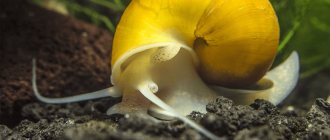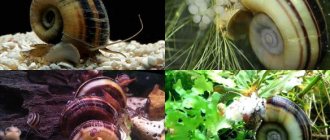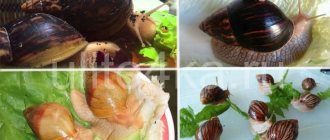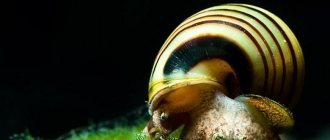I can’t say that ampullaria snails appeared in our country as planned. I really wanted to have an animal in the house that requires minimal care and causes few problems. Therefore, we chose fish. We bought a Cockerel fish and an aquarium and got ready to enjoy the aquatic world.
Then I wanted to give the fish some friends, and that’s how two ampoule snails appeared. Small, pretty, nimble - it’s a pleasure to watch them. A few days later, our fish died and the ampularia snails were left alone.
I would like to note that the correct name of these mollusks is written with two letters l, that is, ampullaria.
Description and characteristics
Decorative types of ampullaria have long been familiar to fans of the underwater depths - the unpretentiousness, visual appeal and benefits of ampullaria snails have made the mollusks popular in the aquarium hobby.
The appearance of these gastropods is typical for all representatives of the genus: the shell is in the form of a spiral, and the color of the shell varies depending on the species. There are three varieties: golden, giant and Australian. Popular among aquarists are the yellow (golden) ampullaria and the color subspecies that were bred thanks to the efforts of breeders: white, blue, pink, black and blue ampullaria. The blueberry variety is also beautiful - a snail with a dark purple shell that looks great on light-colored soil.
The size of the ampularia in the aquarium depends on the diet and capacity of the container, but usually the dimensions of the mollusks do not exceed 10-15 cm. A distinctive feature of snails is their acute sense of smell, thanks to which pets recognize the appearance of food and rush to the food source. Many aquarists, before getting a mollusk, are interested in how long ampularia live. If the snail is kept in the aquarium correctly, the pet will live up to 3-4 years.
Ampularia snail in a home aquarium
Ampularia is a type of gastropod mollusk. The snail has a curled shell that is light brown with darker stripes, although the color can vary from very light to very dark. This mollusk has a small horny cap located on the back of the leg; this cap is nothing more than a kind of “door” for Ampularia, with the help of which it closes the mouth of its shell when it hides in it.
Ampularia is capable of absorbing oxygen not only from water, but also from atmospheric air. The breathing apparatus consists of two halves. The right one is like the gills of fish, and the left one is like the lungs of land dwellers. The snail has a special siphon tube into which it pumps air, rising to the surface of the water. Therefore, a gastropod can get to land and even lay eggs there, saving them from being eaten by aquatic predators.
Its shell can reach 7–8 centimeters in diameter. The leg is also of considerable size: its length can be up to 9 centimeters and its width 3 - 4 centimeters. The mollusk has a pair of eyes and two pairs of tentacles, which act as organs of touch. These animals have a keen sense of smell, which allows them to accurately determine the presence of food in their immediate vicinity.
The most popular shellfish for keeping in home aquariums are those colored yellow. But there are many more color options: pearl, pink, white, blue, purple, black.
Maintenance and care
Novice aquarists note that sometimes when keeping snails in an aquarium, the pets suddenly want to leave the tank. Such an escape means only one thing - the mollusks do not like the conditions, and the pets express protest with such behavior. Despite the fact that these gastropods are not capricious, the life expectancy and health of snails directly depends on the following conditions:
- Parameters of the aquatic environment - hardness should be moderate, since the snail shell is destroyed in soft water. The temperature ranges from 20-27C, but it should be noted that the higher the number of degrees, the shorter the ampoule will live. In cold water, the mollusks will die immediately.
- Reservoir – Given their size, gastropods require a large container. There should be 15 liters of water per snail.
- Equipment – the presence of a lid is mandatory, otherwise obstinate pets will run away. There should be empty space between the cover and the water surface so that the snails can breathe. The tank is equipped with a filter.
- Decorations – decorations are not important for ampullaria, but an aquarium shell, marble chips and limestone will help increase rigidity.
- Quantity - for ampullaria, maintenance requires the population of 4-5 mollusks, since yellow snails prefer the company of their relatives.
- Reproduction of ampularia requires control by the owner. Even taking into account how long snails live, within 2-3 years of life in an aquarium, mollusks are capable of multiplying to a huge population.
It should be noted that failure to comply with maintenance rules threatens the death of snails. If the pet dies, the body is immediately removed from the tank to avoid poisoning of the aquatic environment.
Keeping ampularia in an aquarium
Ampoules can be kept in an aquarium with a volume of 20 liters or more, with at least 5 liters of water per mollusk. The water must be clean , so a filter is needed in the aquarium. Regular water changes in the container are also required.
The temperature in the aquarium where such pets are kept can be from 18 to 30 degrees, that is, the ampoule snail is suitable for sharing with various tropical fish. At high temperatures, the activity of ampularia increases sharply, making them very interesting to watch. True, they live at this temperature noticeably less, a year and a half.
Considering the natural habitat of ampullaria, one can guess that they are undemanding to water quality. But you need to know that a lack of calcium in the water can cause the destruction of the mollusk shell. To saturate the water with calcium, it is enough to place fragments of sea shells or limestone on the bottom of the aquarium. If a natural source of calcium is not at hand, then there are special preparations on sale that increase water hardness.
Ampularia is a peaceful aquarium inhabitant , so it easily gets along with all its inhabitants. But their eggs and offspring, as well as themselves, can become prey for turtles and some species of fish. Crustaceans can easily pull a mollusk out of its shell and eat it.
It’s another matter when fish can disturb the ampoule, tearing off its antennae or piercing the shell. If someone tears off part of a snail's body, it will quickly recover. The ability to regenerate is the best that nature has given them. Ampularia restores all parts of the body, even the eyes.
If the fish in an aquarium with snails get sick, you need to be careful with the use of medications - what is beneficial for the fish is fatal for the mollusk, since aquarium species are biologically closer to parasites than to fish. When treating fish, temporarily remove snails from the aquarium . Place them in a glass jar with a volume of 5 liters or more, covering it with glass. There should be a hole between the glass and the jar for air access.
Diseases of ampularia are little known to the general public, with the exception of ulcers that appear on the shells. The destruction of the snail's house is associated with low water hardness and suboptimal feeding. To build a high-quality shell, your pet needs a lot of calcium compounds.
The lifespan of the ampularia snail depends on the water temperature and conditions. At high water temperatures, 26 - 28 degrees, and non-ideal conditions, the ampullary eyelids can last only a year or a year and a half and the snail dies of old age. Therefore, in most cases, it is easier to get offspring or acquire young mollusks than to treat old ones.
Ampoules are incompatible with: Sumatran barbs, green tetradon, clown loach, fakaka, large cichlids. Shrimp and crayfish will also cause trouble for snails - they can pick out the snail's body from the shell and eat it.
You can keep ampularia with any non-aggressive fish. And, for example, cichlids will always strive to bite off its whiskers, or pull out the entire snail by them. Labyrinths also cannot peacefully coexist with these mollusks. An aquarium with these mollusks must have a lid , since ampullaria are big fans of traveling.
Nutrition
Aquarium ampullaria snails are valued by owners for their good appetite. The question of how to feed your pets does not require an answer - snails calmly find food for themselves, vigorously eating leftover food from the bottom, dead parts of plants, dead fish in a common aquarium. Thanks to their appetite, mollusks bring great benefits, cleaning the tank from dirt and waste, and preventing poisoning and rotting in an artificial reservoir. In addition, young ampullaria cope well with brown and red algae, which pose a threat to the inhabitants of the reservoir.
However, in the absence of food, the snail switches to living underwater flora, destroying young shoots of plants. To prevent this from happening, the mollusks are periodically fed. What to feed the ampoule:
- Tablets for catfish.
- Greens: lettuce and cabbage leaves boiled in boiling water.
- Fresh vegetables: cucumbers, zucchini, carrots.
All types of ampullaria are voracious and grow rapidly, growing from miniature snails into adult representatives.
What to feed different types of ampularia
Pomacea diffusa prefers dead and rotting plants. Sometimes it can feast on softer plants. Representatives of this species are well suited for an aquarium with many beautiful aquatic plants. And if Pomacea diffusa does not receive enough food, it will die of starvation surrounded by untouched plants.
Representatives of this type of ampullaria consume various fish food well. It is also beneficial for them to eat some soft vegetables if there is no plant food for them in the aquarium. You can feed ampullaria snails algae tablets, but other fish food will also benefit them. A very convenient option is floating fish food - it will float on the surface and will not pollute the bottom of the aquarium, and its remains can be easily removed. Such food may seem unsuitable for snails, but ampullaria will cope with it perfectly - they rise to the surface, form a funnel with their feet, with the help of which they collect food, and then consume the obtained food.
Pomacea canaliculata, Pomacea maculate, Pomacea paludosa and Marisa cornuarietis are not as selective in their choice of food and consume all vegetation indiscriminately.
These types of ampularia need to be fed with regular vegetables and herbs:
- salad,
- cucumber,
- small pieces of carrots,
- zucchini,
- pumpkin,
- cabbage,
- spinach,
- green beans and celery,
- fish food.
It is very important to wash vegetables thoroughly before feeding them to gastropods. Preference should be given to seasonal vegetables grown without the use of pesticides. It is advisable to scald the cabbage with boiling water, and boil the remaining vegetables a little.
Compatibility
In a common aquarium, mollusks feel cozy and calm, and even lay eggs, provided that the neighbors are selected correctly. Ampularia caviar and the pets themselves will be safe if peaceful and friendly fish live nearby. It is not recommended to place the following representatives in the same tank with snails:
- Barbs.
- Cichlids.
- Botsiya.
- Tetradons.
These types of fish love to bite off the antennae of poor snails, and if possible, they will even snack on the mollusk itself. In addition to them, crayfish (including marbled crayfish in an aquarium) and shrimp are capable of getting defenseless ampullaria. Predatory Helena will not touch adult snails, but eggs and young snails - easily.
Reproduction
To breed shellfish at home successfully, you need to know how ampullaria snails reproduce. Ampularia are not hermaphrodites, therefore, in order to breed pets, you should buy two representatives of different sexes. It is almost impossible to determine the sex of gastropods - this can only be done by experienced aquarists who have been keeping and breeding mollusks for many years. Therefore, it is easier to immediately purchase 5-6 snails, including both male and female representatives.
In order for the ampularia to lay eggs, the following conditions must be met in the aquarium:
- Temperature – 26-28C.
- Plenty of food.
- The distance between the tank lid and the water surface is at least 12-15 cm.
Snails lay eggs only if all the points above are met. In order for viable offspring to appear, ampoule eggs must be moist. It is important not to let it get too wet or dry out, otherwise the eggs will die. The color of the eggs can range from light pink to greenish.
The maturation of the clutch lasts 3-4 weeks, and the imminent appearance of snails will be indicated by the darkening of the eggs. As soon as the tiny snails are born, the babies will fall into the water, where they will become lunch for the fish, so before birth, the owner should move the eggs as follows:
- The eggs and the surface on which they lie are slightly moistened with some water.
- After a minute, the masonry is carefully shifted onto a flat object and taken to a previously prepared tank.
Breeding
Mollusks reproduce in spring and summer. After mating, the female lays eggs, usually in the evening, outside, on the walls of the tank. Owners can prepare the place in advance - attach a piece of polystyrene foam or a plastic bottle to the glass of the aquarium. If the masonry falls into the water, it will disappear. Also, do not allow the eggs to be heated by a lamp, otherwise there will be no offspring.
During the ripening process, the laid pink eggs change color and become darker. The offspring appears after a few weeks; the temperature must be maintained at +21...+27 °C. The humidity should be high, and you need to make sure that condensation does not get on the masonry. When the eggs hatch, they end up in the water and live independently.
It is better to isolate small individuals so that they are not destroyed by other inhabitants of the aquarium.
They are fed scalded cyclops, lettuce, and duckweed. The water is changed regularly. If desired, the parents can be placed in a separate container, creating the same conditions as in an aquarium, and removed after the eggs have formed. Snails reproduce often and then they will become crowded.
Caring for snails
Baby snails often die at home, so snails require care in the first days of life. In their natural habitat, tiny mollusks feed on high-protein foods, so babies won’t last long on plant food. If the owner wants to preserve the offspring, he will need to install a filter in the container where the newborns live and feed them.
Suitable food for small snails:
- Fish food reduced to pulp.
- Soft algae.
- Boiled egg yolks, pre-chopped.
- Boiled beef minced.
- Daphnia.
You can feed snails with food for adult mollusks at the age of 4-5 weeks. The diet is changed gradually, starting from two weeks of age. As the gastropods grow, they are sorted, sending the grown mollusks to the aquarium with adult mollusks.
Girl or boy?
Even if we agree that Achatina (or other types of land mollusks) are hermaphrodites, this does not mean that they can give birth without the participation of a second individual. Each snail has male and female reproductive organs. Therefore, mollusks are able to mate with each other. As a result, genetic material is transferred from one of them to the other.
In a “family” pair of snails, each of them has its own role. It has been noticed that the responsibilities of the female are taken over by larger and more mature mollusks. Accordingly, young Achatina, which are smaller in size, become males.
If it is decided to breed snails, and there is only one individual available, a pair is selected for it, based on the size and age of the partner. This way, it will be possible to know exactly what sex the snail is.
It also happens that two Achatina live in a home terrarium, but the pair of them does not form and there may be no offspring at all. Even bisexual mollusks are not always able to create a “family,” which must be taken into account when forming a pair.
But it also happens the other way around: each of the snails begins to lay eggs.
Achatina is a bisexual creature, so there’s no need to rack your brains about what name to call her. Each individual can have either a female or a male name. This will depend solely on the personal preferences of its owner.
Being in the same container, two mature individuals can lay clutches one faster than the other. As a result, a large number of newborn snails will be born. If the mollusks do not like each other, there may be no offspring at all.
Diseases
Aquarium ampullaria snails are considered one of the hardiest and most unpretentious, but despite these characteristics, the mollusks can get sick. The most common ailments are:
- Coma - develops when the reservoir is overcrowded, which causes oxygen deficiency. Because of this, mollusks hibernate, burying themselves in the substrate. Increasing the volume of the aquarium or moving some of the inhabitants will help solve the problem.
- Destruction of the shell - occurs due to soft water. To restore the shell, you should increase the hardness and introduce lettuce and cabbage into the diet.
Do snails need vitamins?
Aquarium inhabitants receive chemical elements, minerals, and vitamins from the water in which they live. The chemical composition of water is very important not only for fish, but also for snails: stable pH and carbonate hardness KH, the normal presence of magnesium, iodine, vitamin B. The aquarist should keep control over the purity of the water and oxygen saturation.
The above vitamins, balanced and standardized, should be purchased at pet stores. Their choice today is great - powders, tablets, jelly, cream, dry mixtures. In general, shellfish need the same vitamins as fish. The main thing is that the preparations must sink to the bottom so that they reach the snails. Aquatic inhabitants will thank the owner with their beauty.











